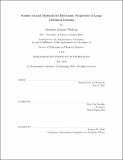| dc.contributor.advisor | Troy Van Voorhis. | en_US |
| dc.contributor.author | Welborn, Matthew Gregory | en_US |
| dc.contributor.other | Massachusetts Institute of Technology. Department of Chemistry. | en_US |
| dc.date.accessioned | 2016-09-30T18:24:50Z | |
| dc.date.available | 2016-09-30T18:24:50Z | |
| dc.date.copyright | 2016 | en_US |
| dc.date.issued | 2016 | en_US |
| dc.identifier.uri | http://hdl.handle.net/1721.1/104463 | |
| dc.description | Thesis: Ph. D. in Physical Chemistry, Massachusetts Institute of Technology, Department of Chemistry, 2016. | en_US |
| dc.description | This electronic version was submitted by the student author. The certified thesis is available in the Institute Archives and Special Collections. | en_US |
| dc.description | Cataloged from student-submitted PDF version of thesis. | en_US |
| dc.description | Includes bibliographical references (pages 169-196). | en_US |
| dc.description.abstract | In this thesis, we explore various approaches to modeling electronic properties of large chemical systems, a challenge for theoretical and computational chemistry. We first model experimental systems with conventional electronic structure by excerpting a region of interest: a few amino acids near the reactive site of a protein, an exciplex dimer in a thin-film LED, and a few donor/acceptor molecules at an organic/organic interface. We find that these models work well for explaining experiments provided we can identify a local region that captures the property of interest. Second, we consider a situation in which the property of interest is not local. We investigate the Anderson model of localization in disordered materials, using the tools of random matrix theory. We use free probability to approximately compute the density of states of a Hamiltonian matrix ensemble without exact diagonalization. We develop an error analysis for this method, and show that it is accurate to the eighth moment of the density of states. Finally, we apply the method to various extensions of the Anderson model, to good result. Third, we develop a wavefunction-in-wavefunction embedding theory for strongly correlated systems. We base our work on Density Matrix Embedding Theory (DMET). We extend the original DMET equations to account for correlation in the bath via an antisymmetrized geminal power (AGP) wave function. The resulting formalism has a number of advantages. First, it allows one to properly treat the weak correlation limit of independent pairs, which DMET is unable to do with a mean-field bath. Second, it associates a size extensive correlation energy with a given density matrix (for the models tested), which AGP by itself is incapable of providing. Third, it provides a reasonable description of charge redistribution in strongly correlated but non-periodic systems. We then describe a new electronic embedding method based on DMET, dubbed "Bootstrap Embedding," a self-consistent wavefunction-in-wavefunction embedding theory that uses overlapping fragments to improve the description of fragment edges. We find Bootstrap Embedding converges rapidly with embedded fragment size, overcoming the surface-area-to-volume-ratio error typical of many embedding methods. Fourth, we employ semiempirical neglect of diatomic differential overlap (NDDO) methods as force fields for liquid water. Using force matching, we design a reparameterized NDDO model and find that it qualitatively reproduces the experimental radial distribution function of water, as well as various monomer, dimer, and bulk properties that standard NDDO method do not. This suggests that the apparent limitations of NDDO models are primarily due to poor parameterization and not to the NDDO approximations themselves. We identify the physical parameters that most influence the condensed phase properties. These results help to elucidate the chemistry that a semiempirical molecular orbital picture of water must capture. We conclude that properly parameterized NDDO models could be useful for simulations that require electronically detailed explicit solvent, including the calculation of redox potentials and simulation of charge transfer and photochemistry. | en_US |
| dc.description.statementofresponsibility | by Matthew Gregory Welborn. | en_US |
| dc.format.extent | 196 pages | en_US |
| dc.language.iso | eng | en_US |
| dc.publisher | Massachusetts Institute of Technology | en_US |
| dc.rights | M.I.T. theses are protected by copyright. They may be viewed from this source for any purpose, but reproduction or distribution in any format is prohibited without written permission. See provided URL for inquiries about permission. | en_US |
| dc.rights.uri | http://dspace.mit.edu/handle/1721.1/7582 | en_US |
| dc.subject | Chemistry. | en_US |
| dc.title | Studies of and methods for electronic properties of large chemical systems | en_US |
| dc.type | Thesis | en_US |
| dc.description.degree | Ph. D. in Physical Chemistry | en_US |
| dc.contributor.department | Massachusetts Institute of Technology. Department of Chemistry | |
| dc.identifier.oclc | 958676505 | en_US |
